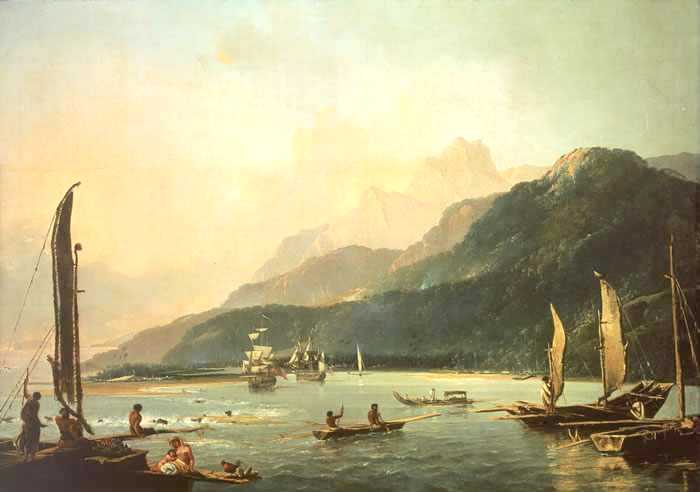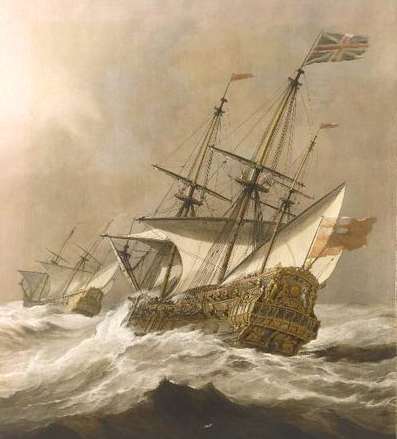|
HMS RESOLUTION
|
|
HOME | BIOLOGY | FILMS | GEOGRAPHY | HISTORY | INDEX | INVESTORS | MUSIC | SOLAR BOATS | SPORT |
|
HMS Resolution was a sloop of the Royal Navy, the ship in which Captain James Cook made his second and third voyages of exploration in the Pacific. She impressed him enough that he called her "the ship of my choice", and "the fittest for service of any I have seen."
She began her career as the North Sea collier Drake, launched at Whitby in 1770, was renamed Marquis of Granby, and purchased by the Royal Navy in 1772. She was fitted out at Deptford with the most advanced navigational aids of the day, including a Gregory Azimuth Compass, ice anchors and the latest apparatus for distilling fresh water from sea water. Twelve light 6-pound guns and twelve swivel guns were carried. At his own expense Cook had brass door-hinges installed in the great cabin. Resolution cost the Admiralty £4,151. It was originally planned that the naturalist Joseph Banks with an appropriate entourage would sail with Cook, so a heightened waist, an additional upper deck and a raised poop deck were built to suit Banks. However, in sea trials the ship was found to be top-heavy, and under Admiralty instructions the offending structures were removed. Banks refused to travel under the resulting "adverse conditions" and was replaced by Johann Reinhold Forster and his son, George. The conversion had cost a further £6,565.
HMS Resolution of 1773 - Tahiti, Matavai Bay
When she sailed from Plymouth on July 13, 1772 with HMS Adventure, her complement totaled 112, including 20 volunteers who had sailed on Cook's first voyage in HMS Endeavour in 1768–1771. On Resolution's second voyage (Cook's third voyage) she again carried 112.
On his first voyage Cook had calculated longitude by the usual method of lunars but on her second voyage the Board of Longitude sent William Wales, a highly qualified astronomer, with Cook and entrusted a new chronometer, the K1, recently completed by Larcum Kendall, together with three chronometers made by John Arnold of Aldophi. Kendall's K1 was remarkably accurate and was to prove to be most efficient in determining longitude on board Resolution.
On January 17, 1773, Resolution was the first ship to cross the Antarctic Circle and crossed twice more on the voyage. The third crossing, on February 3, 1774, was the most southerly penetration, reaching latitude 71°10′ South at longitude 106°54′ West. Resolution thus proved Alexander Dalrymple's Terra Australis Incognita to be a myth. On Cook's third voyage, Resolution crossed the Arctic Circle on August 17, 1778, and again crossed it on July 19, 1779, under the command of Charles Clerke after Cook's death.
In 1780, Resolution was converted into an armed transport and sailed for the East Indies in March 1781. She was captured by the Sphinx of de Suffren's squadron on June 9, 1782. After the action at Negapatam on 6 July 1782, Resolution was sent to Manila for wood, biscuit and rigging, and to enter any seaman she found there. She sailed on July 22, 1782 and was never seen again.
On June 5, 1783 de Suffren wrote that Resolution was last seen in the Sunda Strait, and that he suspected that she had either foundered or fallen into the hands of the English. An item from the Melbourne Argus, February 25, 1879, says that she ended her days as a Portuguese coal-hulk at Rio de Janeiro, but this has never been confirmed. Viscount Galway, a Governor-General of New Zealand, owned a ship's figurehead described as that of Resolution, but a photograph of it does not agree with the figurehead depicted in Holman's famous water-colour of her. Wikipedia GNU credit
General Characteristics
HMS Resolution of 1678
A taste for adventure capitalists
Solar Cola - a healthier alternative
|
|
This
website is Copyright © 1999 & 2006
Solar Cola Ltd. The bird logo |
| AUTOMOTIVE | BLUEBIRD | ELECTRIC CARS | ELECTRIC CYCLES | SOLAR CARS |

